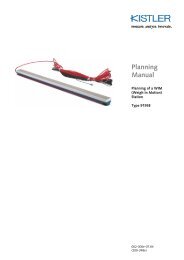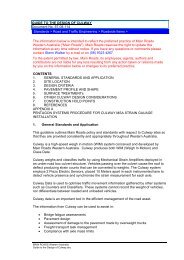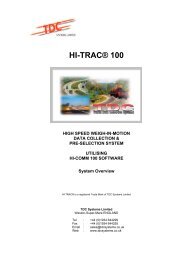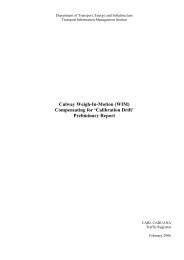AP-G84/04 Best practice in road use data collection, analysis ... - WIM
AP-G84/04 Best practice in road use data collection, analysis ... - WIM
AP-G84/04 Best practice in road use data collection, analysis ... - WIM
You also want an ePaper? Increase the reach of your titles
YUMPU automatically turns print PDFs into web optimized ePapers that Google loves.
Accessed by AR - ARRB TRANSPORT RESEARCH on <strong>04</strong> Feb 2005<br />
8 CONCLUSIONS<br />
Aust<strong>road</strong>s 20<strong>04</strong><br />
— 51 —<br />
<strong>Best</strong> Practices <strong>in</strong> Road Use Data Collection, Analysis and Report<strong>in</strong>g<br />
This report has successfully compiled and highlighted best <strong>practice</strong>s <strong>in</strong> <strong>road</strong> <strong>use</strong> <strong>data</strong> <strong>collection</strong>,<br />
<strong>analysis</strong> and report<strong>in</strong>g. Road <strong>use</strong> <strong>data</strong> is a complex topic and the materials <strong>in</strong> this report are the<br />
f<strong>in</strong>d<strong>in</strong>gs of an Aust<strong>road</strong>s Road Use Data Workshop held <strong>in</strong> October 2003 <strong>in</strong> Melbourne, and the<br />
many feedback and suggestions from the Project Work<strong>in</strong>g Group members. A key f<strong>in</strong>d<strong>in</strong>g of this<br />
project is that RAs have been follow<strong>in</strong>g similar pr<strong>in</strong>ciples <strong>in</strong> traffic count <strong>data</strong> <strong>collection</strong> and<br />
<strong>analysis</strong>. Road authorities have ref<strong>in</strong>ed their count<strong>in</strong>g programs and <strong>in</strong> many ways have achieved<br />
good <strong>practice</strong>s.<br />
The pr<strong>in</strong>ciples of best <strong>practice</strong>s are enunciated <strong>in</strong> the report (Section 2). These pr<strong>in</strong>ciples <strong>in</strong>clude<br />
accuracy, effectiveness, efficiency, reliability, accessibility, transparency, timel<strong>in</strong>ess and relevance.<br />
They also relate to the issue of <strong>data</strong> <strong>in</strong>tegrity (Section 6). The issue of transparency deserves<br />
special attention beca<strong>use</strong> it is a key means at enhanc<strong>in</strong>g consistency <strong>in</strong> <strong>data</strong> <strong>collection</strong>, <strong>analysis</strong><br />
and report<strong>in</strong>g amongst RAs and facilitate accessibility of current and potential <strong>use</strong>rs of <strong>road</strong> <strong>use</strong><br />
<strong>data</strong>.<br />
Another key <strong>data</strong> <strong>in</strong>tegrity issue is the method of manag<strong>in</strong>g miss<strong>in</strong>g <strong>data</strong>. It is recognised that<br />
each RA has its own procedure <strong>in</strong> handl<strong>in</strong>g miss<strong>in</strong>g <strong>data</strong>, and that there is no standard way of<br />
address<strong>in</strong>g the issue. This report provides the current procedures adopted <strong>in</strong> RTA NSW and Ma<strong>in</strong><br />
Roads WA as examples of good <strong>practice</strong>s. In particular, the software developed by RTA-CSIRO<br />
us<strong>in</strong>g the method of Hidden Markov Model could prove <strong>use</strong>ful amongst RAs after the necessary<br />
tests are completed.<br />
The topics of vehicle detection and classification are also discussed. Most issues related to these<br />
topics have been addressed over many years. It is generally accepted that the Aust<strong>road</strong>s 12-b<strong>in</strong><br />
classification by axle configuration is stable and well-received s<strong>in</strong>ce its <strong>in</strong>ception <strong>in</strong> 1994. M<strong>in</strong>or<br />
variations are recommended as follows:<br />
Introduction of an error b<strong>in</strong> (b<strong>in</strong> 13) to account for the quality of classified counts;<br />
Distribution of vehicles from the error b<strong>in</strong> <strong>in</strong>to either b<strong>in</strong> 1 (the passenger-car b<strong>in</strong>) or across<br />
all twelve b<strong>in</strong>s depend<strong>in</strong>g on the error b<strong>in</strong> size, or us<strong>in</strong>g both methods mak<strong>in</strong>g <strong>use</strong> of<br />
knowledge of on-site traffic conditions;<br />
Standardisation of classify<strong>in</strong>g vehicles <strong>in</strong>to four or five b<strong>in</strong>s by vehicle lengths; and<br />
Recognition of m<strong>in</strong>or variations amongst RAs, but sub-classified counts by either axle<br />
configurations or vehicle lengths must be capable of aggregat<strong>in</strong>g <strong>in</strong>to the Aust<strong>road</strong>s system<br />
(13 b<strong>in</strong>s by axles or 4 or 5 b<strong>in</strong>s by lengths).<br />
In the case of vehicle classification by lengths, there is no standard established system yet.<br />
Indeed, it may be appropriate to adopt a 5-b<strong>in</strong> system to sub-classify comb<strong>in</strong>ation vehicles so<br />
manufacturers can design their equipment accord<strong>in</strong>gly. The five b<strong>in</strong>s can be aggregated <strong>in</strong>to four<br />
b<strong>in</strong>s where necessary. Some field tests and calibration to determ<strong>in</strong>e the appropriate threshold<br />
values of vehicle lengths for each b<strong>in</strong> are recommended.<br />
The <strong>use</strong> of a s<strong>in</strong>gle axle sensor for traffic count <strong>collection</strong> is quite common amongst RAs, even<br />
though most have recognised the need for classified counts. It is recommended that traffic counts,<br />
as a default, be reported <strong>in</strong> vehicle numbers. If the raw <strong>data</strong> is <strong>in</strong> the form of axles or axle-pairs,<br />
then the count should be converted to vehicles with the conversion factor also reported if possible,<br />
adopt<strong>in</strong>g the pr<strong>in</strong>ciple of transparency.

















